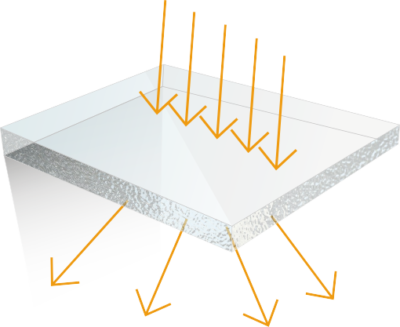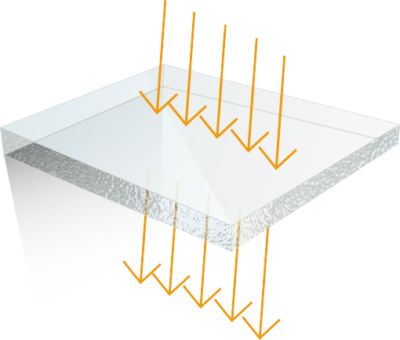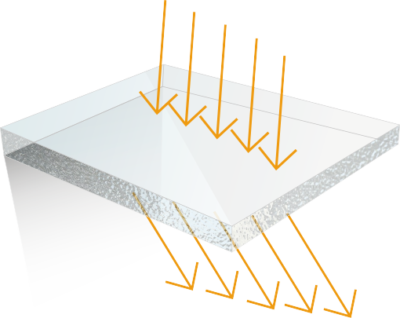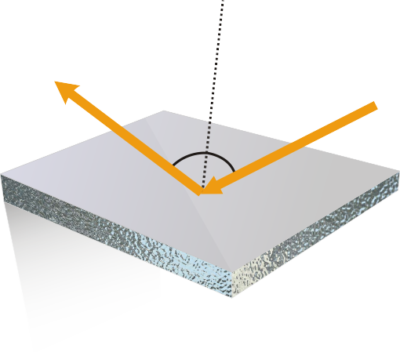Do you know the Haze, transmittance, refraction, gloss ?When light is incident on the surface of an object
1. Specular reflection occurs on the surface of the object. It is the main reason for the gloss of the surface of the object.
2. When the light incident into the object, scattering occurs inside the object, resulting in diffuse reflection and diffuse transmission.
3. When diffuse reflection and diffuse transmitted light propagate in the object, different bands of light will produce different absorption, resulting in different colors from the incident light.
4. When the object is more transparent, part of the light will directly pass through the object to produce transmission.
The color of the light source is determined by the spectral distribution of the light source. The color of an object is determined by the spectral characteristics of the surface of the object. The direction of the specular reflected light depends on how smooth the surface of the object is. Depending on the degree of surface roughness, specular reflected light produces different spatial distributions.
In layman’s terms, we can understand the concept of haze as the ability to scatter light. As shown in the figure above, the light is scattered.
The greater the haze, the stronger the scattering ability of the material to light, and the more difficult it is for our human eyes to see. For example, frosted glass, standing at the other end of the glass, the human eye cannot see the scene on the other side of the glass, but the glass can transmit light. (The wall also can’t see the other side, but the wall blocks the light.) )
In the mobile phone and automotive industries, haze is often measured.
The written interpretation is: the ratio of the scattered luminous flux that deviates from the direction of the incident light through the specimen to the transmitted luminous flux, expressed as a percentage. Typically, only scattered luminous fluxes that deviate more than 2.5 degrees from the direction of incident light are used to calculate haze.

Haze
The transmittance is relatively easy to understand, which can be understood as the ability of light to penetrate the material, and has nothing to do with the direction of light propagation after transmission. The higher the transmittance, the more light transmits. For example, glass windows and curtains, glass windows require light transmission, curtains require as opaque as possible.
The advent of the intelligent era, the rise of touch screens, began to have high requirements for the transmittance of many materials, many materials began to need to detect transmittance, and often, transmittance and haze generally need to be detected at the same time.
For transmittance, the written interpretation is: the ratio of the luminous flux through the specimen to the luminous flux hitting the specimen, expressed as a percentage.

Transmissivity
We are no strangers to the phenomenon of refraction of light, so what is the difference and connection between haze and refraction?
Refraction is when a certain light passes through a medium and the direction of propagation changes. This change in angle is certain, from the sensory experience, that is, you can still see the opposite scene, but the position has changed, the real example is that the chopsticks bend in the water, but the underwater part still looks like chopsticks.
But haze, can be understood as because of the material, there are different directions of refraction, forming the scattering of light, at this time, it is impossible to see the opposite scene.
Rigorous description of refraction: When light is obliquely emitted from one transparent medium into another transparent medium, the direction of propagation generally changes, this phenomenon is called light refraction.

Refraction
Gloss is actually a completely different concept from the above three, the above three are the transmission phenomenon of transparent objects, and gloss is for the specular reflection of light on the surface of the object.
Gloss can be understood as the subtle “roughness” of the surface of an object. That is, the smoother and more “reflective” the surface, the more “bright” the human eye feels, and the higher the gloss.
There are a wide range of industries that need to measure gloss, and gloss meters are generally used.
Written explanation: Gloss is a physical quantity that evaluates the ability of a material surface to reflect light specularly.

Gloss
LISUN lauched Haze Meter and Spectrophotometer HM-700 is designed for color, haze, spectral transmittance and total transmittance measurement of transparent and translucent materials such as plastic sheets, films, glass, LCD panel and touch screen, etc.
Benchtop Spectrophotometer (Reflectance and Transmittance) DSCD-920 adopts 7 inches touch screen, full wavelength range, Android operate system. Illumination : reflectance D/8° and transmittance D/0°(UV included / UV excluded), high accuracy for color measurement, large storage memory, PC software, because of above advantages, it is used in laboratory for color analysis and communication
Lisun Instruments Limited was found by LISUN GROUP in 2003. LISUN quality system has been strictly certified by ISO9001:2015. As a CIE Membership, LISUN products are designed based on CIE, IEC and other international or national standards. All products passed CE certificate and authenticated by the third party lab.
Our main products are Goniophotometer, Integrating Sphere, Spectroradiometer, Surge Generator, ESD Simulator Guns, EMI Receiver, EMC Test Equipment, Electrical Safety Tester, Environmental Chamber, Temperature Chamber, Climate Chamber, Thermal Chamber, Salt Spray Test, Dust Test Chamber, Waterproof Test, RoHS Test (EDXRF), Glow Wire Test and Needle Flame Test.
Please feel free to contact us if you need any support.
Tech Dep: Service@Lisungroup.com, Cell/WhatsApp:+8615317907381
Sales Dep: Sales@Lisungroup.com, Cell/WhatsApp:+8618117273997
Your email address will not be published. Required fields are marked *